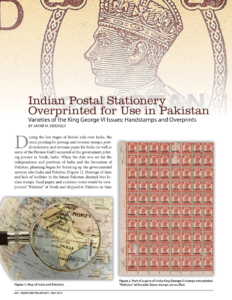[APS/APRL press release]
United States Stamp Society Barbara R. Mueller Award for Best Article in The American Philatelist (for the year 2015):
 This year’s winner is Jafar H. Siddiqui for Indian Postal Stationery Overprinted for Use in Pakistan, published in the July issue of the journal.
This year’s winner is Jafar H. Siddiqui for Indian Postal Stationery Overprinted for Use in Pakistan, published in the July issue of the journal.
Jafar H. “Jeff” Siddiqui has been a stamp collector since age 6 and joined the APS in 1983. His main focus includes the stamps, covers, and postal stationery of British India and Pakistan. He is the originator of Pakphil, a free newsletter on Pakistan philately published by the Pakistan Study Circle, United Kingdom. His article chronicled the use of Indian postal stationery provided for use by postal patrons in Pakistan until the availability of the first official overprinted stamps in October 1947.
The award is named for the United States Stamp Society and for one of its most prominent members, authors, and editors, Barbara R. Mueller. Among her many other honors in six decades of devotion to philately, Mueller is a member of the Hall of Fame of both the United States Stamp Society and APS Writers Unit 30. She was the recipient of the APS John N. Luff Award for Distinguished Philatelic Research in 1956.
Thomas F. Allen Award for the best article published in a single year of The Philatelic Literature Review (for the year 2015)
This year’s winner is Brian Birch for his article, “Who Really Founded the American Philatelic Society, Theodore F. Cuno or Schuyler B. Bradt?”
Brian’s interest in stamps was sparked at the age of 9 when their father gave his two sons stamp albums and a small packet of stamps. With two worldwide collectors in the same household, change was inevitable in order to avoid conflict. It was agreed that Brian should collect Commonwealth and his brother, David, European stamps, and that they would collaborate on the rest of the world.
Following some training in information science at the British Library, Brian transferred his interest to the literature of philately and the stamp collection was abandoned. With no collection to support, the standard monographs and handbooks held little interest for him and he chose to specialize in philatelic bibliography and the history of philately, its literature and its adherents. This change in direction led him to begin a number of bibliographies which expanded to a greater extent than expected and became substantial books. Although he spent a great deal of time in compiling some of these over the past 30 or so years, it was evident that their scope was such that they would never be finished and so could never be conventionally published. Accordingly, they have all been placed on the FIP literature Commission website and are updated each year. The site, fipliterature.org, currently holds more than 6,500 pages of Brian’s freely available bibliographic and biographical research.
Brian joined the American Philatelic Society and American Philatelic Research Library in 1976, subsequently becoming a Patron and Life Member of the latter. He is also a Fellow of the Royal Philatelic Society London (1981) and a member of the Collectors Club of New York (1983). Although he had always published the occasional article, retirement gave him the time to at least begin to catch up on all of the projects that had been started and then laid aside for lack of time.
His article in the 1st Quarter 2015 issue of the Philatelic Literature Review titled “Who Really Founded the American Philatelic Society, Theodore F. Cuno or Schuyler B. Bradt?” epitomizes the kind of in-depth research and inquiry that the PLR aims to encourage, and the detailed endnotes provide a solid basis for future scholarship.
The award is named for Allen, who was the editor and co-author of the book, 19th Century Cleveland Ohio Postal Markings, and received an international gold medal for his Cleveland postal markings exhibit. Past president of the U.S. Philatelic Classics Society and an editor of its publication, Allen served as president, secretary and treasurer for the Garfield Perry Stamp Club and was actively involved in the club’s annual March Party show.



